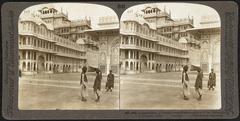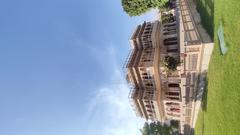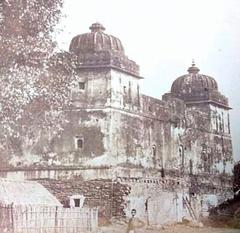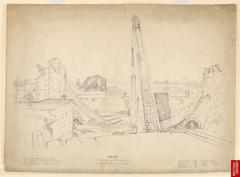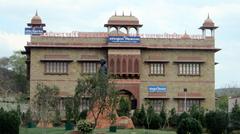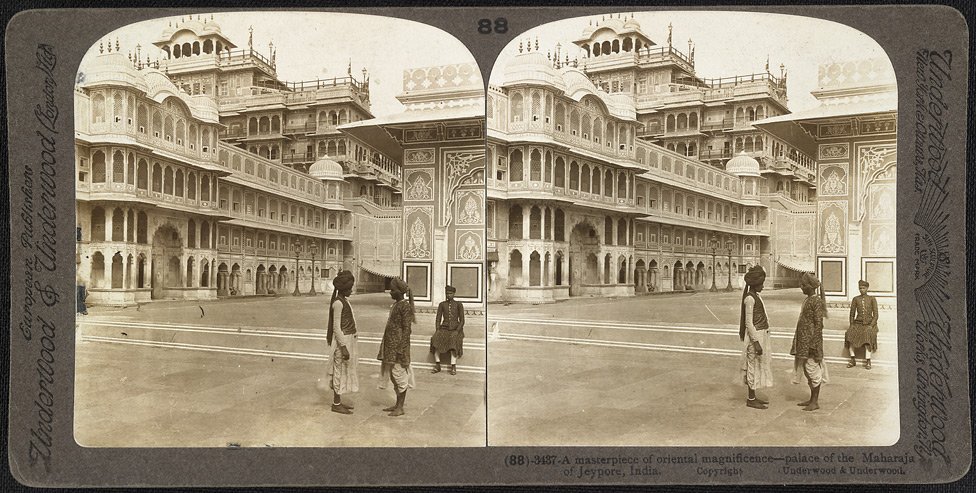
City Palace Jaipur Visitor Guide
Date: 16/07/2024
Introduction
The City Palace in Jaipur, India, is a monumental testament to the city’s rich history and cultural heritage. Established between 1727 and 1732 by Maharaja Sawai Jai Singh II, the palace complex offers a captivating blend of Rajput, Mughal, and European architectural styles. This guide will provide you with detailed historical insights, architectural marvels, and practical visitor information, including ticket prices, visiting hours, and travel tips. Whether you’re a history enthusiast or a traveler planning your visit, this comprehensive guide has you covered. The City Palace served as the administrative and ceremonial seat of the Maharaja of Jaipur, embodying the eclectic tastes of the ruling dynasty (Jaipur City Palace). Over the centuries, successive rulers made significant additions and modifications to the complex, ensuring it remains a vibrant reflection of Jaipur’s royal heritage (Cultural India).
Table of Contents
- Introduction
- History
- Architectural Highlights
- Practical Visitor Information
- Historical Significance
- Cultural and Artistic Contributions
- Preservation and Modern-Day Relevance
- Key Historical Events
- Special Events and Tours
- FAQ
- Conclusion
History
Foundation and Early History
The City Palace in Jaipur was established in 1727 by Maharaja Sawai Jai Singh II, the founder of Jaipur. The construction of the palace began simultaneously with the founding of the city itself, which was designed by the Bengali architect Vidyadhar Bhattacharya. The palace served as the administrative and ceremonial seat of the Maharaja of Jaipur. The architectural style of the City Palace is a blend of Rajput, Mughal, and European influences, reflecting the eclectic tastes of the ruling dynasty (Jaipur City Palace).
Architectural Evolution
Over the centuries, successive rulers of Jaipur made significant additions and modifications to the City Palace complex. The palace’s architecture evolved to include a series of courtyards, gardens, and buildings. Notable structures within the complex include the Chandra Mahal, Mubarak Mahal, and the Diwan-i-Khas. Each of these buildings showcases a unique architectural style and serves a specific purpose within the palace complex (Cultural India).
Architectural Highlights
Chandra Mahal
The Chandra Mahal is the most prominent building within the City Palace complex. It is a seven-storied structure that served as the residence of the Maharaja. Each floor of the Chandra Mahal has a distinct name and function. The topmost floor, known as the Mukut Mahal, offers a panoramic view of the city. The Chandra Mahal is adorned with beautiful frescoes, mirror work, and intricate carvings, reflecting the opulence of the royal family (Rajasthan Tourism).
Mubarak Mahal
The Mubarak Mahal, or the “Auspicious Palace,” was built in the late 19th century by Maharaja Madho Singh II. This building was designed to serve as a reception hall for visiting dignitaries. The Mubarak Mahal is an excellent example of the fusion of Islamic, Rajput, and European architectural styles. Today, it houses a museum that displays a collection of royal costumes, textiles, and artifacts (Jaipur Travel Guide).
Diwan-i-Khas
The Diwan-i-Khas, or the “Hall of Private Audience,” is another significant structure within the City Palace complex. This hall was used by the Maharaja to meet with his courtiers and important guests. The Diwan-i-Khas is renowned for its two giant silver urns, which are listed in the Guinness Book of World Records as the largest silver objects in the world. These urns were used by Maharaja Sawai Madho Singh II to carry holy Ganges water during his trip to England in 1901 (Guinness World Records).
Diwan-i-Aam
The Diwan-i-Aam, or Hall of Public Audience, was used for public audiences and is adorned with intricate decorations and a collection of miniature paintings, ancient texts, and embroidered rugs. The ceiling of the hall is particularly impressive, with its elaborate design and vibrant colors (Rajasthan Tourism).
Pritam Niwas Chowk
Pritam Niwas Chowk, or the Courtyard of the Beloved, serves as the entrance to the Chandra Mahal. The courtyard is famous for its four small gates, each representing a different season. The Peacock Gate represents autumn, the Lotus Gate represents summer, the Green Gate represents spring, and the Rose Gate represents winter. Each gate is intricately decorated with motifs and designs that reflect the season it represents (Rajasthan Tourism).
Bhaggi Khana
Bhaggi Khana is a museum within the City Palace complex that houses a collection of old carriages, palanquins, and European cabs. This museum provides a glimpse into the royal transportation methods used by the Maharajas of Jaipur. Among the notable exhibits is the Victoria Baggi, a carriage gifted to the Maharaja by the Prince of Wales in 1876 (Rajasthan Tourism).
Maharani Palace
The Maharani Palace, or Queen’s Palace, was originally the residence of the royal queens. Today, it has been converted into a museum that displays a vast collection of Rajput weaponry, including swords, shields, and guns. The ceiling of the palace is adorned with beautiful frescoes, and the walls are decorated with intricate mirror work (Rajasthan Tourism).
Govind Dev Ji Temple
The Govind Dev Ji Temple is a significant religious site within the City Palace complex. Dedicated to Lord Krishna, this temple is one of the most important and revered temples in Jaipur. The temple’s architecture is a blend of Hindu and Mughal styles, and it is known for its beautiful deity idol and vibrant festivals, especially Janmashtami (Govind Dev Ji Temple).
Sabha Niwas
Sabha Niwas, also known as the Hall of Private Audience, is another important attraction within the City Palace. This hall was used by the Maharajas for private meetings and discussions. The hall is adorned with beautiful chandeliers, intricate mirror work, and a collection of royal portraits (Rajasthan Tourism).
Sarvato Bhadra
Sarvato Bhadra is an open-air pavilion within the City Palace complex. This pavilion was used for various ceremonies and functions, including the coronation of the Maharajas. The pavilion is surrounded by a beautiful garden and offers a serene and peaceful environment (Rajasthan Tourism).
Practical Visitor Information
Visiting Hours and Ticket Prices
- Visiting Hours: The City Palace is open daily from 9:30 AM to 5:00 PM.
- Ticket Prices:
- Indian visitors: INR 200
- Foreign tourists: INR 700
- Additional charges apply for camera and video equipment.
- Special Events: The palace hosts various cultural events and festivals throughout the year. Check the official website for the latest updates (City Palace Official Website).
Travel Tips
- Best Time to Visit: The best time to visit Jaipur and the City Palace is between October and March when the weather is pleasant.
- Nearby Attractions: While visiting the City Palace, consider exploring nearby attractions such as the Hawa Mahal, Jantar Mantar, and the Amber Fort.
- Accessibility: The City Palace is accessible to wheelchair users, with ramps available at key points in the complex.
- Guided Tours: Guided tours are available and highly recommended for a deeper understanding of the palace’s history and architecture.
Historical Significance
The City Palace has played a crucial role in the history of Jaipur and the broader region of Rajasthan. It was not only the residence of the royal family but also the center of administration and governance. The palace complex was the site of important ceremonies, including coronations, royal weddings, and state functions. The City Palace also served as a symbol of the Maharaja’s power and authority, reflecting the grandeur and sophistication of the Jaipur royal court (Rajasthan History).
Cultural and Artistic Contributions
The City Palace has made significant contributions to the cultural and artistic heritage of Jaipur. The palace complex is home to a vast collection of art, including paintings, manuscripts, and decorative arts. The royal family of Jaipur were patrons of the arts, and their support helped to foster a vibrant cultural scene in the city. The City Palace continues to be a center for artistic and cultural activities, hosting exhibitions, performances, and workshops that celebrate the rich traditions of Rajasthan (Art and Culture).
Preservation and Modern-Day Relevance
In the post-independence era, the City Palace has been meticulously preserved and maintained by the royal family of Jaipur. Parts of the palace complex have been converted into museums, showcasing the rich cultural heritage of Rajasthan. The City Palace remains a popular tourist destination, attracting visitors from around the world who come to admire its architectural splendor and historical significance. The palace also continues to host cultural events and festivals, keeping the traditions of the Jaipur royal family alive (Jaipur Tourism).
Key Historical Events
Several key historical events have taken place at the City Palace, further cementing its importance in the annals of Jaipur’s history. For instance, the palace was the site of the grand coronation ceremony of Maharaja Sawai Man Singh II in 1922. During the British colonial period, the City Palace hosted numerous British officials and dignitaries, serving as a venue for diplomatic engagements. The palace also played a role in the integration of Jaipur into the Indian Union in 1949, marking the end of princely rule and the beginning of a new era for the city (Indian History).
Special Events and Tours
The City Palace hosts various events and guided tours, including cultural performances, royal ceremonies, and night tours. These events offer a unique glimpse into the royal heritage and traditions of Jaipur (Special Events).
FAQ
- What are the visiting hours for City Palace Jaipur? The City Palace is open daily from 9:30 AM to 5:00 PM.
- How much are the tickets for City Palace Jaipur? Tickets for Indian visitors are priced at INR 200, while tickets for foreign tourists cost INR 700.
- Are guided tours available at City Palace Jaipur? Yes, guided tours are available and recommended.
- Is City Palace Jaipur accessible to wheelchair users? Yes, the palace is accessible with ramps available at key points.
Conclusion
The City Palace in Jaipur stands as a testament to the city’s rich history and cultural heritage. Its architectural grandeur, historical significance, and ongoing preservation efforts make it a must-visit destination for anyone interested in the history and culture of Rajasthan. The palace complex offers a glimpse into the opulent lifestyle of the Jaipur royal family and serves as a reminder of the city’s glorious past. From its intricate frescoes and mirror work to its vast collection of royal artifacts, the City Palace is not just a monument but a living example of Jaipur’s royal legacy. For more updates and travel tips, follow us on social media or check out other related posts on our website (Jaipur City Palace).
References
- Jaipur City Palace, n.d., https://www.jaipur.org.uk/monuments/city-palace.html
- Cultural India, n.d., https://www.culturalindia.net/monuments/city-palace-jaipur.html
- Rajasthan Tourism, n.d., https://www.tourism.rajasthan.gov.in/jaipur/city-palace.html
- Guinness World Records, n.d., https://www.guinnessworldrecords.com/world-records/largest-silver-objects
- Jaipur Travel Guide, n.d., https://www.jaipurtravelguide.com/city-palace.html
- Rajasthan History, n.d., https://www.rajasthanhistory.com/city-palace-jaipur.html
- Jaipur Tourism, n.d., https://www.jaipurtourism.co.in/city-palace-jaipur
- Indian History, n.d., https://www.indianhistory.com/city-palace-jaipur.html
- Art and Culture, n.d., https://www.artandculture.com/city-palace-jaipur
